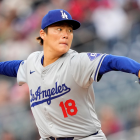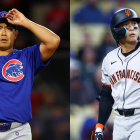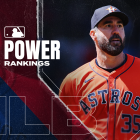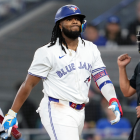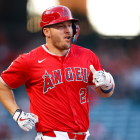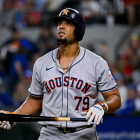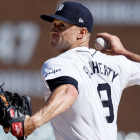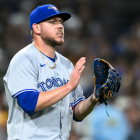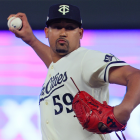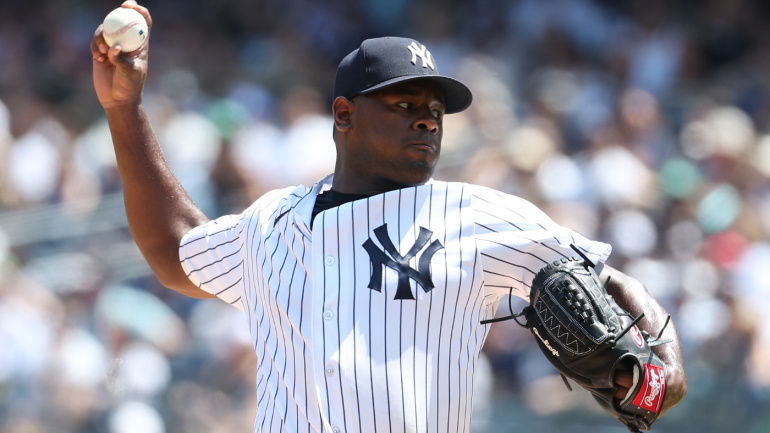
With David Stearns' first offseason in charge of the New York Mets winding down, it's fair to write that he didn't prioritize making a grand introduction (or at least didn't succeed in doing so). In a departure from recent winters that saw the Mets add impressive starpower -- including Max Scherzer and Justin Verlander -- Stearns has had the same kind of offseason he could've had in the past with the Milwaukee Brewers.
Entering Tuesday, Stearns had given out just one multi-year contract, with that going to left-hander Sean Manaea, and none worth more than $14 million annually. Manaea's deal, the richest of the Mets' winter, was tied for the 20th largest of the entire offseason -- behind two different Kansas City Royals signings and one recently executed by Stearns' old friends in Milwaukee. Again, not the marks of a typical offseason under Steve Cohen's ownership.
There's always a risk of confusing dynamics when ascribing a larger motivation to a single offseason. For instance, Stearns reportedly chased after Yoshinobu Yamamoto, suggesting he wasn't wholly opposed to adding a top-end free agent given the opportunity. Still, we're willing to take that risk to point out a different apparent pattern of the Mets winter: to our eyes, it sure looks like Stearns and company are confident in their ability to get the most from a collection of talented yet flawed pitching additions.
Getting troubled big arms and coaching them up isn't the most oblique strategy, but it is one the Mets seem to have fully embraced. Between Luis Severino, Sean Manaea, Jorge López, Jake Diekman, and Shintaro Fujinami, the Mets have added five pitchers with wider error bars than the average bear. Indeed, Severino, López, and Fujinami each had ERAs over 5.00 in 2023. Manaea and Diekman's successes, meanwhile, come equipped with their own questions.
With that in mind, below CBS Sports has highlighted those five new Mets arms by explaining both their variability and why they're intriguing nevertheless. (Do note that the pitchers are presented in no particular order.)
1. RHP Luis Severino
The contract: One year, $13 million
The risk: Severino is only a few years removed from receiving Cy Young Award consideration in consecutive winters. Unfortunately, he's dealt with a slew of physical issues in the time since. He was downright miserable last season, too, posting a 6.65 ERA and calling himself "the worst pitcher in the game." His season then ended prematurely because of an oblique injury.
Luis Severino's 4Ks thru 2. pic.twitter.com/LQ0J6cU5Tp
— Rob Friedman (@PitchingNinja) September 8, 2023
The reward: As we noted in Severino's top-50 free-agent ranking capsule, his arsenal generated better pitch-quality metrics than you would expect from someone who allowed a .279 average or better on three of his four main offerings. Severino continued to pound the zone, too, with more than 66% of his pitches going for strikes. Above-average control of above-average stuff tends to be a winning formula. Now, if only he can stay on the mound.
2. LHP Sean Manaea
The contract: Two years, $28 million
The risk: Manaea has, more often than not, been a league-average starter or better throughout his big-league career. He suffered through a poor 2022 season, however, and he got off to a worse start last year, finishing the first half with a 5.49 ERA. To his credit he did rebound, but it's fair to have concerns about someone who was subpar for the majority of the last two seasons.
Sean Manaea's 3Ks in the 2nd. pic.twitter.com/4sMHElL8vi
— Rob Friedman (@PitchingNinja) September 28, 2023
The reward: Our Mike Axisa recently noted some adjustments Manaea made last year that allowed him to post a 3.43 ERA in the second half. Long story short: Manaea's performance gains coincided with him throwing harder and deploying an improved sweeper that helped both his strikeout and ball-tracking measures. Can he maintain that output over a full season?
3. RHP Jorge López
The contract: One year, $2 million
The risk: Be honest: did you remember that López made the 2022 All-Star Game? If not, it's because it's the only time in his career he's been effective at the big-league level. In that sense, last year's poor performance (5.95 ERA in 61 appearances across three teams) was a return to form for him.
Jorge López, K'ing the Side. pic.twitter.com/nCF2FxwKV5
— Rob Friedman (@PitchingNinja) April 8, 2023
The reward: It took the Orioles multiple seasons to "fix" López, something that no other team has been able to do before or since. (Including the Orioles themselves) You can understand why the Mets are willing to try their hand anyway. López still maintains good stuff, including a mid-90s sinker and a pair of swing-and-miss breaking balls. Perhaps the Mets can help him get back to being an extreme ground-ball pitcher as well. Last season's 47% grounder rate was his lowest since the 2019 campaign, when he was still a starter.
4. LHP Jake Diekman
The contract: One year, $4 million (plus a vesting option)
The risk: If it's hard to believe Diekman is already 37 years old, it's probably because he's defied the passage of time by boasting the same basic profile for more than a decade. He's walked at least five batters per nine innings in each of his last seven seasons, regardless of how many appearances he's made or how he's performed overall. Predictably, his ERA+ has fluctuated up and down like a bobber. Here's his last six, in order: 98, 100, 1003 (not a typo), 107, 83, and 128.
Jake Diekman's 3Ks in the 8th. pic.twitter.com/g6gJsq5O4X
— Rob Friedman (@PitchingNinja) September 16, 2023
The reward: We mentioned that Diekman has had the same basic profile throughout his career. We omitted that he's been a reliable strikeout artist. To wit, his 11.4 per-nine strikeout rate since 2012 ranks 10th among pitchers with at least 500 innings during that span. Diekman, long a fastball-slider hurler, actually mixed up his arsenal for the first time in a while. He threw a career-high 14.7% changeups, resulting in a .189 average against, a 22% whiff rate, and a new full-season best for OPS versus right-handed batters (.524). Diekman's changeup isn't particularly impressive on its own -- you won't see anyone compare it to Bugs Bunny's cambio -- but within the greater context of his arsenal, it might be enough to help steady him.
5. RHP Shintaro Fujinami
The contract: One year, $3.35 million
The risk: You may have heard that Fujinami was, throughout his younger days, considered Shohei Ohtani's rival. Not any longer. While Ohtani was en route to a $700 million contract, Fujinami's first season in MLB resulted in a 7.18 ERA. He was one of six pitchers (min. 70 innings) last season to average more than a home run and five walks surrendered per nine innings. Another year like that could force him to return to Japan, or, at least, settle for a minor-league pact.
Shintaro Fujinami, Wicked 86mph Sweeper. 🤢 pic.twitter.com/5r5vkrZrqi
— Rob Friedman (@PitchingNinja) September 14, 2023
The reward: For as poorly as Fujinami fared in his "rookie" year, he actually received a slight raise after making $3.25 million in 2023. Consider that a testament to his raw stuff. Fujinami averaged 98.4 mph with his fastball last season, and that undersells it given his deep release point. He also threw two other pitches, a splitter and a cutter, that generated more than 30% whiffs. He did a better job of generating chases following a midseason trade to the Orioles, and he'll need to continue to improve in that respect if he's going to overcome what can be charitably described as below-average command. Should there be such a thing as a make or break season, this would be it.














